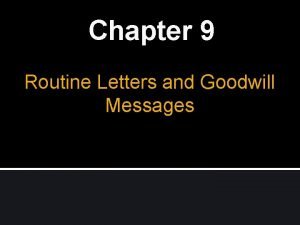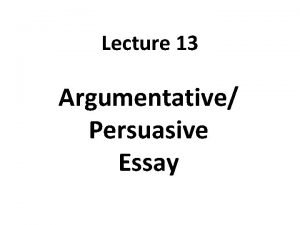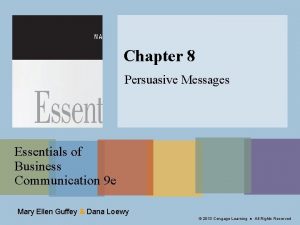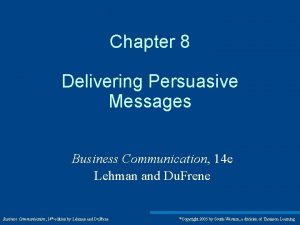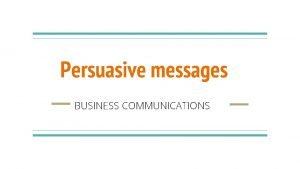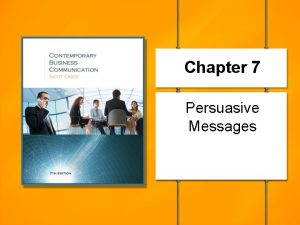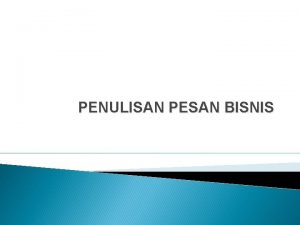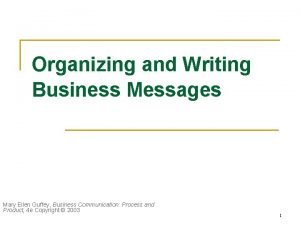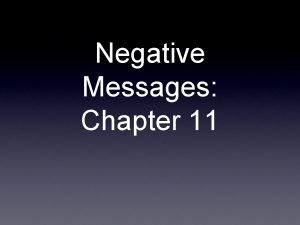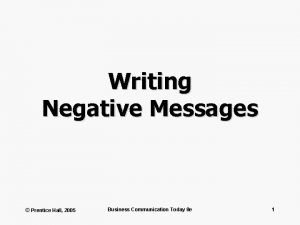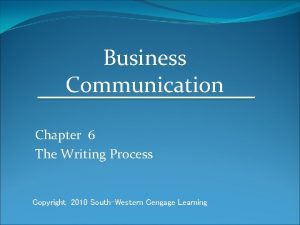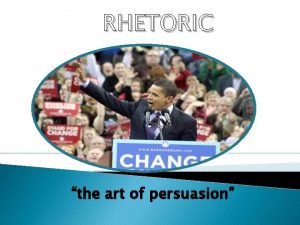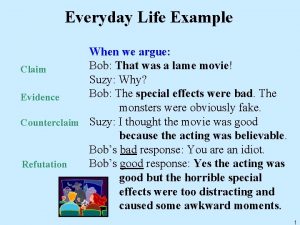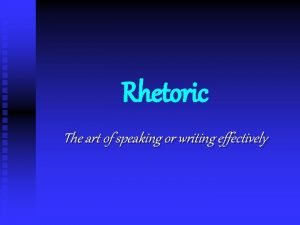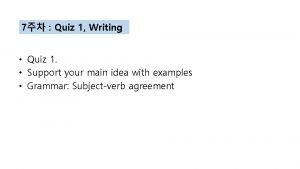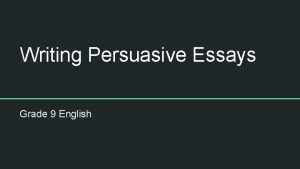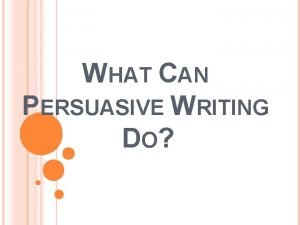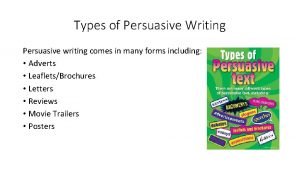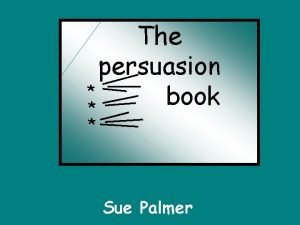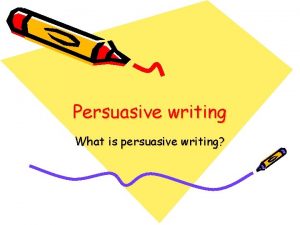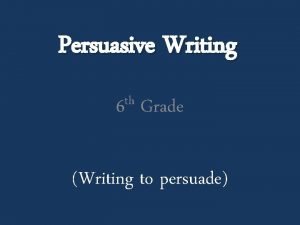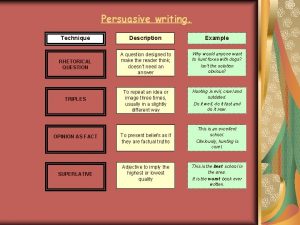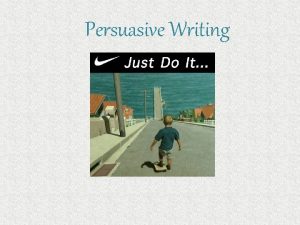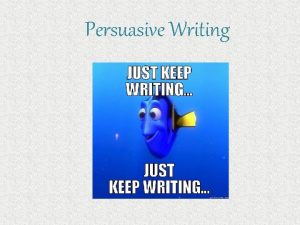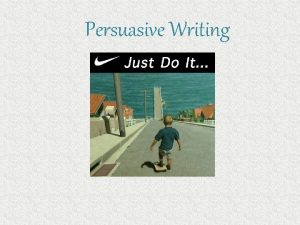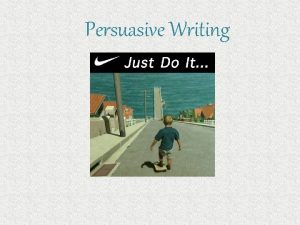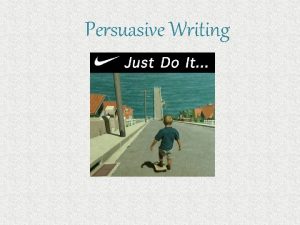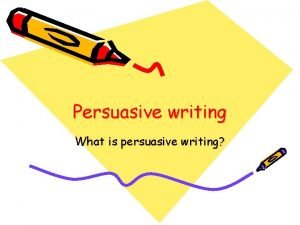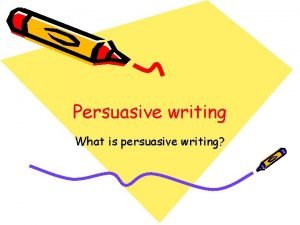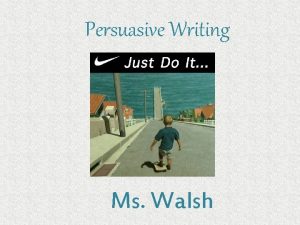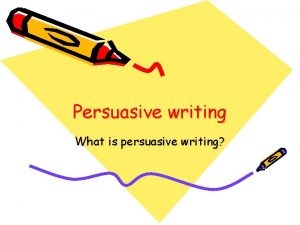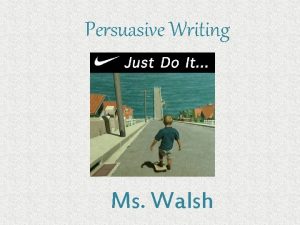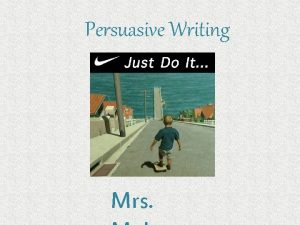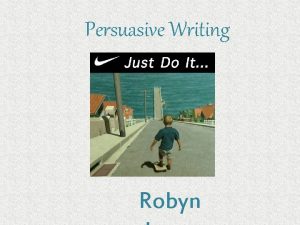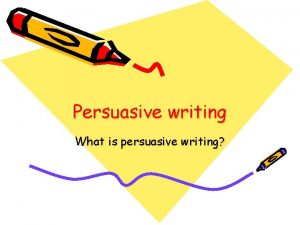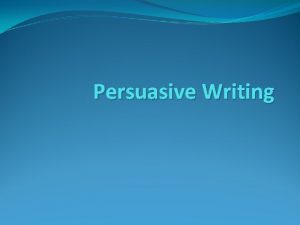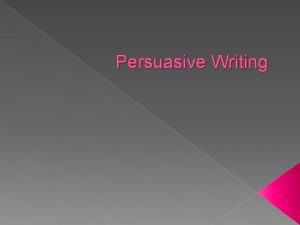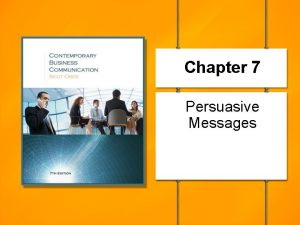Chapter 9 Writing Persuasive Messages Letters and Marketing





































- Slides: 37

Chapter 9: Writing Persuasive Messages: Letters and Marketing Messages

Chapter 9: Learning Objectives • Applying the three-step writing process to persuasive messages • Developing persuasive business messages • Categories of persuasive business messages • Developing marketing and sales messages • Promotional messages for social media • Avoiding ethical lapses in marketing and sales messages

Tips for Success “When it comes to writing engaging content, ‘you’ is the most powerful word in the English language, because people are ultimately interested in fulfilling their own needs. ” -Brian Clark, Entrepreneur and blogger www. copyblogger. com

Using the Three-Step Writing Process for Persuasive Messages

3 step writing process Plan-outline your message, do your research, decide on your audience profile. Choose direct or indirect approach Write-Decide on a format, and know the correct way to use this format (persuasive letter outline) Complete- edit/peer edit, refine.

Planning Persuasive Messages • • • Credibility Facts Common ground Sincerity Sources Enthusiasm Trust Expertise Objectivity Good intentions

Writing Persuasive Messages Use positive language Consider differences Establish credibility Use logic, evidence and compelling narratives

Completing Persuasive Messages High production quality Judge your argument objectively Design elements Proofread

Developing Persuasive Business Messages

Anticipating Objections Address objections before the audience does For hostile audiences, present all sides and explain the pros and cons of each. Involve the audience

Some things to watch for… -Logical Flaws • Hasty generalizations • Attacking an opponent • Oversimplifying • Cause and effect assumption • Faulty analogy

Other Examples of Persuasive Business Messages (not letters) -Marketing Messages -Promotional Messages

Maintaining High Ethical and Legal Standards Messages must be truthful and nondeceptive ‘Bait Back up claims with evidence and switch’ advertising is illegal

The AIDA Model A-Attention-How? (squirrel!) -colourful -big bold words -lots of colour -primary colours I-Interest-How? (Customer wants and needs) -variety -Mc. Donald’s logo-building on consumer knowledge D-Desire-How? (customer wants and needs) - “im lovin it”-you will too - “Bliss”-burgers bring bliss - Double, Big, Deluxe A-Action-How? Not present-perhaps these were new burgers when the ad was released?

A-Attention-How? (Squirrel!) -colourful -big bold words -lots of colour -primary colours I-Interest-How? (customer wants and needs) -variety -Mc. Donald’s logo-building on consumer knowledge -Free D-Desire-How? (Customer Wants) - “im lovin it”-you will too - “Free”-benefit - Big, Premium, “A” A-Action-How? “Get Yours Today!” “Free Big Mac When You Visit”

Try the Assignment: Analyzing Advertising Messages Using AIDA! Try to find some really effective ones!!!

Real-World Applications When writing persuasive messages, why is it so important to give special attention to the analysis of your purpose and audience? Let’s discuss!

Chapter 10 Understanding and Planning Reports and Proposals

Chapter 10: Learning Objectives • Adapting the three-step writing process to reports and proposals • Informational reports • Organizing analytical reports • Planning proposals

Tips for Success “Written reports are essential for evaluating business opportunities. Without the facts, boards can’t act. ” -Gerry Roy, Chief Corporate Officer and Legal Counsel, Inualiut Regional Corporation

The Three-Step Writing Process Reports and Proposals: Planning

Reports and Proposals Reports: Give information Proposals: Propose or suggest action • Guide decisions • Monitor and control operations • Comply with government regulations • Implement policies and procedures • Document results

Reports Informational Monitor and control operations Summarize Explain Submit Comply with government regulations Implement policies and procedures Document progress Analyze-#s Evaluate-#s Recommend Analytical-think Numbers! Analytical • • • Troubleshooting reports Feasibility reports Justification reports • Internal • External • Solicited • Unsolicited

Reports Create a Plan- looks kind of like our other message plans. . ; ) • Statement of the problem and the purpose of the report (thesis) • List tasks to be accomplished (info/evidence) • Description of final products or outcomes (conclusion)

Organizing Your Information Direct approach Indirect approach • Efficient • Forceful • Persuasive • Diplomatic

Selecting the Right Medium • Is a particular medium required by the organization? • How will feedback be provided? • Is your medium searchable or updatable? • Does the medium itself send a message?

Planning Informational Reports

Organizing Informational Reports Category Geography Chronology Importance

Planning Analytical Reports

Focusing on Conclusions Direct approach • Audience is likely to accept your conclusion • Support your conclusion with solid reasoning and evidence

Focusing on Recommendations Direct approach 1. Establish need for action 2. Introduce benefits 3. List steps required to achieve benefit 4. Explain each step 5. Summarize recommendations © 2013 Pearson Canada Inc. Business Communication Essentials Chapter 10 - 31

Planning Proposals • Internal proposals • External proposals • Solicited (direct approach) • Unsolicited (indirect approach)

Format Usually report format is governed by your company (letterhead etc. ) You still must: Be succinct State the problem, issue or topic Give evidence and support State what you would like to do with that information (proposal) Close cordially

Special Report/Proposal Format: The Memo A memo is a formal note used in an office. A memo can give information, advise of company policies and procedures, or give information regarding issues in the workplace. Basically a report that sometimes requires you to perform an action. Has special format, as it is official.

Top of the Memo

Body of the Memo

Real-World Applications After an exhaustive study of an important problem, you have reached a conclusion that you believe your company’s management will reject. What will you do? Let’s discuss! © 2013 Pearson Canada Inc. Business Communication Essentials Chapter 10 - 37
 Sky root and grass letters
Sky root and grass letters Definition of business letter
Definition of business letter Routine business messages
Routine business messages Routine letters and goodwill messages
Routine letters and goodwill messages What are routine and goodwill messages?
What are routine and goodwill messages? Persuasive essay vs argumentative
Persuasive essay vs argumentative Argumentative essay vs expository essay
Argumentative essay vs expository essay The closing of a persuasive request should
The closing of a persuasive request should 14. what are persuasive messages?
14. what are persuasive messages? Persuasive message in business communication
Persuasive message in business communication You should not open a persuasive request with a question.
You should not open a persuasive request with a question. Positive business messages examples
Positive business messages examples Informal letter cambridge
Informal letter cambridge Pesan bisnis
Pesan bisnis Academic text example
Academic text example Negative message
Negative message Writing negative messages in business communication
Writing negative messages in business communication Reviewing and correcting the final draft of a message is
Reviewing and correcting the final draft of a message is Rhetoric: the art of persuasive writing and public speaking
Rhetoric: the art of persuasive writing and public speaking Difference between argumentative and persuasive essay
Difference between argumentative and persuasive essay Stir up sympathy persuasive statement
Stir up sympathy persuasive statement Rhetoric: the art of persuasive writing and public speaking
Rhetoric: the art of persuasive writing and public speaking How to write friendly letter
How to write friendly letter How to end email in french
How to end email in french Formal email format
Formal email format Purpose of a friendly letter
Purpose of a friendly letter English
English Symbolism in frankenstein letters 1-4
Symbolism in frankenstein letters 1-4 Complaint letter purpose
Complaint letter purpose Quiz 1: writing letters
Quiz 1: writing letters Pronouns in persuasive writing
Pronouns in persuasive writing English persuasive essay
English persuasive essay I wanna iguana persuasive writing
I wanna iguana persuasive writing Types of persuasive texts
Types of persuasive texts Sue palmer skeleton books
Sue palmer skeleton books Clincher ideas
Clincher ideas Persuasive writing 6th grade
Persuasive writing 6th grade Example of rhetorical question
Example of rhetorical question




